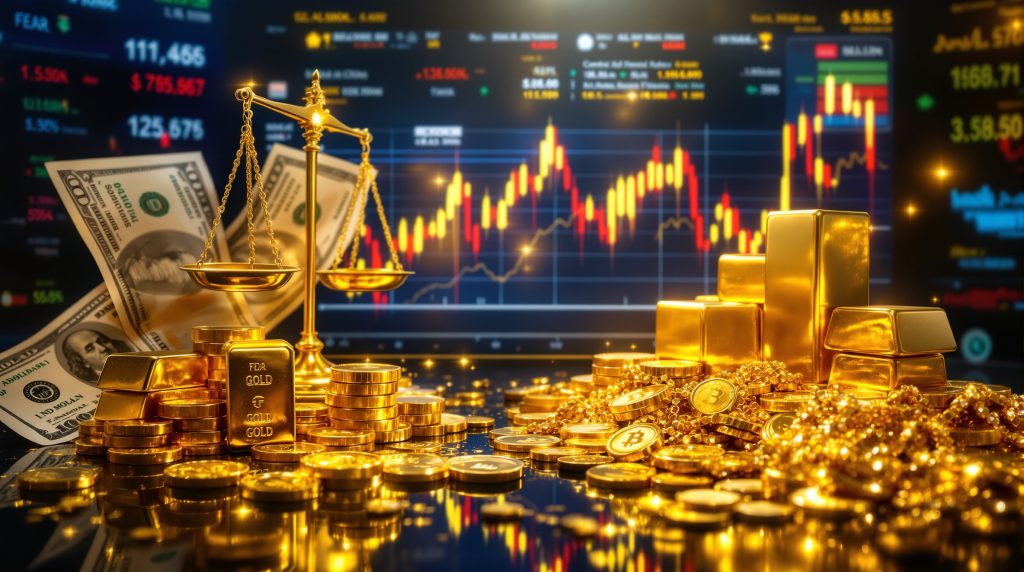What Drives Gold Prices? Understanding the Key Factors
The Inverse Relationship Between Real Interest Rates and Gold
Real interest rates—calculated as nominal rates minus inflation—play a crucial role in gold price movements. When real yields decline, gold's appeal increases significantly despite being a non-yielding asset. Federal Reserve data shows a strong inverse correlation: when 10-year TIPS yields fall by 100 basis points, gold prices typically rise 8-15%.
During periods when real yields turned negative (2008-2012, 2020-2021), gold experienced some of its strongest bull markets. This relationship exists because lower real rates reduce the opportunity cost of holding non-yielding assets like gold.
The technical threshold appears when real yields exceed 2%, historically creating significant headwinds for gold appreciation. Investors monitoring this relationship should track both nominal Treasury yields and TIPS breakeven rates, which reflect market-based inflation expectations.
Inflation's Role as a Price Catalyst
Gold has historically served as gold as an inflation hedge, with prices often rising during periods of high inflation. Bureau of Labor Statistics data confirms gold has outperformed inflation in 15 of the last 20 years when CPI exceeded 3% annually. This relationship exists for several reasons:
- Gold maintains purchasing power when currency values erode
- Investors seek tangible assets during inflationary periods
- Central banks may increase gold reserves to diversify from depreciating currencies
The 1970s stagflation period offers the most dramatic example, when gold rose from $35/oz to over $800/oz as real interest rates remained deeply negative. However, Federal Reserve research indicates that gold's performance as an inflation hedge is most pronounced during periods of unexpected inflation rather than anticipated price increases.
The US Dollar Connection: Why Currency Strength Matters
The gold-dollar relationship typically exhibits inverse correlation, with a -0.7 correlation coefficient over rolling 5-year periods according to Bloomberg Terminal data. This creates a predictable price response pattern:
| US Dollar Movement | Typical Gold Price Response | Reasoning |
|---|---|---|
| Strengthening | Downward pressure | Gold becomes more expensive for foreign buyers |
| Weakening | Upward pressure | Gold becomes more affordable globally |
| Rapid devaluation | Sharp price increases | Investors seek alternative stores of value |
This relationship explains why economic factors weakening the dollar—such as growing US debt levels, potential tariffs impacting economic growth, or interest rate cuts—typically support gold prices. Conversely, during 2022, when real yields rose sharply to +1.5%, gold declined approximately 12% despite ongoing geopolitical tensions.
What Role Do Central Banks Play in Gold Markets?
Monetary Policy Effects on Precious Metals
Central bank policies, particularly from the Federal Reserve, significantly impact gold through multiple channels. Federal Reserve policy transmission affects gold primarily through real interest rate channels, with 25 basis point fed funds rate changes typically moving gold 1-3% in the opposite direction.
Quantitative easing programs have particularly strong effects on gold prices. When central banks expand monetary supply without corresponding economic growth, real interest rates often decline, supporting gold prices. During 2020-2022 QE programs, the Fed's balance sheet expanded by $4.8 trillion while gold rose from $1,500 to over $2,000/oz.
Forward guidance signaling future policy direction can also create anticipatory moves in gold markets, as investors position themselves ahead of expected changes in monetary conditions.
Central Bank Purchasing Trends
Recent years have witnessed substantial central bank gold accumulation. According to the World Gold Council, central banks purchased 1,037 tonnes of gold in 2023 alone—the second-highest annual total on record. This represents a significant shift from previous decades when Western institutions were net sellers of gold reserves.
Total central bank gold holdings reached 36,700 tonnes by end of 2023, representing approximately 17% of all above-ground gold. This accumulation trend has been led by emerging market central banks seeking diversification from traditional reserve currencies.
The People's Bank of China added 225 tonnes to reserves in 2023, continuing 18 consecutive months of purchases. Turkey's central bank increased gold reserves from 116 tonnes to 540 tonnes between 2017-2023 amid currency volatility, highlighting gold's role as a currency crisis hedge.
Central bank reserve managers cite concerns about currency concentration risk and sanctions exposure as primary motivations for increasing gold allocations—a trend that shows no signs of abating.
How Does Market Psychology Drive Gold Prices?
Gold as a "Fear Gauge" During Uncertainty
Gold often serves as a barometer for market anxiety, with its correlation to the VIX (market fear index) increasing to +0.6 during market stress periods compared to just +0.1 during calm markets. Academic research confirms gold functions as a "crisis commodity" with performance improving significantly during the worst 5% of stock market days.
This psychological driver affects gold prices during various types of uncertainty:
- Geopolitical conflicts and tensions (Russia's 2022 Ukraine invasion triggered immediate 8% gold price spike)
- Economic crises and market volatility (March 2020 COVID-19 market crash)
- Banking system instability
- Sovereign debt concerns (European debt crisis 2010-2012 drove gold from $1,200 to $1,900/oz)
Behavioral finance studies indicate retail investors increase gold allocation during periods of high economic uncertainty, independent of fundamental factors, creating demand surges precisely when traditional markets experience disruption.
Investment Demand Through Exchange-Traded Funds
The introduction of gold-backed ETFs in 2003 revolutionized accessibility to gold investment and permanently altered market dynamics. Physical gold ETF holdings reached 3,200 tonnes at their peak in 2020, equivalent to more than one year's mine production.
ETFs significantly impact prices through their structure:
- ETFs must maintain 100% physical backing, requiring immediate market purchases when experiencing inflows
- This creates additional demand beyond traditional jewelry and industrial uses
- ETF inflows/outflows can significantly influence short-term price movements (ETF outflows of 400+ tonnes in 2022 coincided with gold's decline from $2,070 to $1,630/oz)
- The convenience of ETF investing has broadened gold's investor base
The largest gold ETF (SPDR Gold Trust) publishes daily bar lists showing exact serial numbers of gold bars held, providing transparency that further legitimized gold as a mainstream investment class.
What Supply and Demand Factors Influence Gold Prices?
The Limited Global Gold Supply
The world's total extracted gold supply is remarkably finite—all gold ever mined would form a cube roughly 20.4 meters on each side. This physical constraint creates inherent scarcity that underpins gold's value proposition. Current supply dynamics include:
- Annual mining production increases total supply by approximately 2% (3,644 tonnes in 2023)
- Industrial consumption reduces available supply by roughly 2% annually
- Recycling provides approximately 1,200 tonnes annually, representing about 25% of total supply
- This supply constraint creates price sensitivity to demand changes
Mining industry analysts note that high-grade ore reserves are increasingly depleted, requiring more energy-intensive extraction methods that raise production costs. The World Gold Council estimates that 90% of easily accessible gold deposits have already been discovered, limiting future supply growth potential.
South African gold production illustrates this trend dramatically, declining from 1,000 tonnes annually in 1970 to under 100 tonnes in 2023 due to mine depletion. All-in sustaining costs for gold mining averaged $1,348/oz in 2023 across major producers, establishing a loose production floor for prices.
Jewelry and Industrial Demand Dynamics
While investment demand fluctuates with market conditions, baseline consumption comes from several consistent sources:
- Jewelry manufacturing (particularly in China and India) accounts for approximately 48% of annual gold consumption
- Electronics and technology applications consume roughly 300 tonnes annually, with electronics accounting for 70% of industrial demand
- Medical and dental uses provide steady incremental demand
- Aerospace and specialized industrial applications require small but consistent gold volumes
China's jewelry demand fell 12% in 2023 due to economic slowdown, contributing to gold price volatility. India and China together represent 55% of global jewelry purchases, making regional economic conditions in these countries particularly significant for gold price forecast projections.
How Do Physical Gold Market Mechanics Work?
The London Bullion Market and Price Discovery
The global gold market operates through a sophisticated network of exchanges, over-the-counter trading, and physical delivery systems. The London Bullion Market Association estimates daily trading volumes of 5,500 tonnes ($350+ billion) in over-the-counter gold markets, dwarfing physical production.
Price discovery occurs through multiple channels:
- The London PM Fix, established in 1919, uses an electronic auction process administered by ICE Benchmark Administration
- COMEX gold futures daily volume averages 25 million ounces ($50+ billion notional) with only 1-3% resulting in physical delivery
- Settlement occurs through the London Precious Metals Clearing Limited unallocated account system between LBMA members
- London Good Delivery bars (400 oz standard) comprise 99% of wholesale physical gold trading
Market structure analysis shows that paper gold trading volumes exceed annual mine production by a 25:1 ratio, indicating significant leverage in price discovery mechanisms. This creates potential for disconnects between paper and physical markets during stress periods.
Gold Price Premiums and Market Tightness
Physical gold prices can diverge from spot prices during supply constraints, creating arbitrage opportunities and signaling market stress. Physical delivery premiums can spike 10-20% above spot prices during supply shortages, as occurred during COVID-19 lockdowns.
During March 2020, physical gold premiums reached $100/oz over spot prices due to refinery shutdowns and transportation disruptions. This divergence highlighted several market realities:
- Dealer premiums increase during high-demand periods
- Delivery delays may occur when refiners cannot meet demand
- Regional price differences emerge during localized crises
- The spread between paper and physical gold prices widens
The Shanghai Gold Exchange requires 100% physical backing for all contracts, creating pricing differences with London/New York paper markets that occasionally provide insights into physical demand from Asian markets.
What Historical Patterns Have Shaped Gold Prices?
Gold's Performance During Previous Financial Crises
Gold has displayed distinctive behavior patterns during major economic disruptions:
| Crisis Period | Gold Price Movement | Contributing Factors |
|---|---|---|
| 2008 GFC | Initial 25% decline, then 170% rally through 2011 | Liquidity crisis followed by unprecedented monetary stimulus |
| 2011-2012 Euro Crisis | Sharp rise to then-record highs ($1,900/oz) | Sovereign debt concerns, safe-haven demand |
| 2020 COVID-19 | Rapid ascent to new records ($2,089/oz) | Unprecedented monetary stimulus, uncertainty |
Economic historians note that gold's best performance typically occurs 12-24 months after major crisis events, when monetary policy responses take full effect. This delayed reaction pattern helps explain why gold sometimes initially falls during market panics before outperforming during recovery phases.
Gold's Long-Term Price Trajectory
The multi-decade gold price trend shows dramatic evolution following the abandonment of the gold standard:
- Gold rose 2,300% from $35/oz (1971 Nixon Shock) to peak of $850/oz (1980)
- Subsequently declined 70% to $300/oz trough (1999-2001)
- Began significant uptrend in early 2000s
- Accelerated following the 2008 financial crisis
- Consolidated between 2013-2019
- Established new record highs in 2020 and beyond, reaching $2,135/oz in December 2023
Gold's 20-year compound annual growth rate (2004-2024) of 7.8% exceeded inflation by 5.2 percentage points, confirming its long-term purchasing power preservation characteristics. However, inflation-adjusted gold prices reached all-time highs in 1980 at approximately $3,200/oz in 2024 dollars, suggesting potential for further appreciation in real terms.
What Current Factors Are Influencing Today's Gold Market?
Debt Levels and Fiscal Sustainability Concerns
Growing sovereign debt burdens potentially support gold through multiple channels. U.S. federal debt reached $33.7 trillion (125% of GDP) as of December 2024, up from $23 trillion (107% of GDP) in 2020.
Treasury market analysts express concerns about debt sustainability ratios, particularly as interest payments approached 15% of federal revenues in 2024. These fiscal realities create potential gold support through:
- Concerns about long-term currency debasement
- Questions regarding fiscal sustainability
- Potential for future monetary accommodation if debt service becomes problematic
- Reduced confidence in sovereign debt as "risk-free" assets
Historical precedent suggests that when debt-to-GDP ratios exceed certain thresholds, financial repression policies often follow, creating favorable environments for gold market surge insights.
Geopolitical Tensions and Economic Decoupling
Current global tensions create supportive environments for gold through multiple mechanisms:
- Trade disputes and protectionist policies that potentially slow growth and weaken currencies
- Regional conflicts and security concerns driving safe-haven demand
- De-dollarization efforts by certain economies reducing dollar demand
- Supply chain restructuring and resource nationalism affecting commodity prices
Geopolitical risk assessments indicate elevated tensions supporting gold's safe-haven premium, with multiple regional conflicts creating uncertainty. China and Russia's gold accumulation accelerated following 2022 sanctions implementation, highlighting gold's role in sanctions-resistant reserves.
BRICS nations collectively increased gold reserves by 12% in 2023, suggesting coordinated diversification strategies. Middle Eastern sovereign wealth funds increased precious metals allocation from 2% to 5% average during 2022-2024 period, further confirming institutional desire to reduce dollar exposure.
How Can Investors Interpret Gold Price Movements?
Key Technical and Fundamental Indicators
Investors typically monitor several metrics to gauge gold market direction, with particular focus on correlation patterns. Gold's 60-day correlation with S&P 500 ranges from -0.3 during market stress to +0.1 during stable periods, providing valuable insights about prevailing risk sentiment.
Other key indicators include:
- Real yield trends on 10-year Treasury Inflation-Protected Securities (TIPS)
- Dollar Index (DXY) movements as a primary inverse correlation
- ETF inflow/outflow data (SPDR Gold Trust experienced $2.1 billion net inflows in Q4 2023)
- Futures market positioning (CFTC Commitment of Traders reports showed large speculators held net long positions of 240,000 contracts as of December 2024)
- Central bank purchase announcements that signal institutional confidence
These indicators collectively provide a dashboard for assessing gold's likely near-term direction based on technical, sentiment, and fundamental factors.
Gold's Role in Modern Portfolio Construction
Contemporary investment approaches to gold allocation have evolved significantly based on extensive academic research. Portfolio construction research suggests 5-10% gold allocation provides optimal risk-adjusted returns for balanced portfolios over 20+ year periods.
Modern Portfolio Theory calculations show gold's low correlation (0.1-0.3) with stocks and bonds enhances portfolio efficiency through:
- Correlation benefits with traditional assets (especially during crisis periods)
- Inflation protection characteristics
- Liquidity advantages compared to other alternative assets
- Value-at-Risk models indicating gold reduces portfolio downside risk by 15-25% during crisis periods
During the 2022 bear market, portfolios with 10% gold allocation outperformed pure equity/bond portfolios by 180 basis points. Institutional investors like university endowments average 3-8% precious metals allocation for long-term wealth preservation, validating gold's role in sophisticated gold investment strategies.
Frequently Asked Questions About Gold Prices
What typically happens to gold during recessions?
Gold often performs well during recessions, particularly once monetary stimulus begins. However, initial phases of economic contraction can see gold decline as investors liquidate positions to cover losses elsewhere or meet margin calls.
During March 2020, gold initially fell 12% alongside equities before recovering as safe-haven demand emerged. This pattern has repeated across multiple economic cycles, with gold's strongest performance typically coming during the recovery phase when stimulus measures take effect.
How do mining production costs affect gold prices?
While not a direct short-term driver, production costs establish a loose floor for prices over longer periods. When gold prices fall below all-in sustaining costs for a significant portion of producers (currently averaging $1,348/oz), supply constraints eventually develop as marginal mines reduce output.
Higher production costs result from declining ore grades, increasing energy expenses, and stricter environmental regulations. These factors contribute to inelastic supply that responds slowly to price signals, potentially supporting prices during prolonged downturns.
What impact does technological innovation have on gold demand?
Technological advancements create competing effects on gold demand:
- Reduced usage per device in electronics (negative)
- Expanded applications in new technologies like advanced computing (positive)
- More efficient recycling methods (negative)
- New medical and industrial applications (positive)
Industrial applications currently consume roughly 300 tonnes annually, with electronics accounting for 70% of this demand. While this represents a small portion of total annual demand, technological developments continue to create new use cases for gold's unique properties.
Further Exploration:
Readers interested in learning more about gold price drivers can explore educational content from various market sources. Historical price patterns, correlation studies, and detailed market structure analysis can provide deeper insights into how various economic factors influence the precious metals market.
Understanding gold's unique position as both a commodity and monetary asset helps explain its sometimes counterintuitive price movements and provides context for its role in investment portfolios and the global financial system. For those interested in a deeper dive into current market conditions, record‑high gold analysis offers valuable insights into recent price movements.
Ready to Identify the Next Major Mineral Discovery?
Discover why historic mining finds can generate exceptional returns by exploring Discovery Alert's dedicated discoveries page, where the proprietary Discovery IQ model provides real-time alerts on significant ASX mineral discoveries, turning complex data into actionable investment insights. Visit https://discoveryalert.com.au/discoveries/ today to position yourself ahead of the market.




